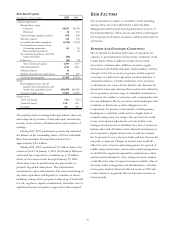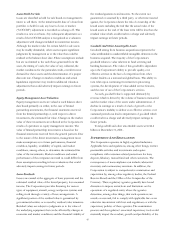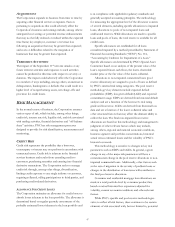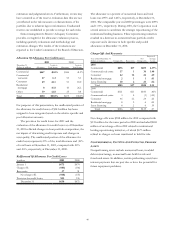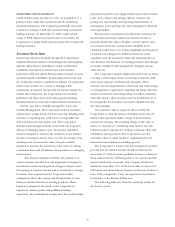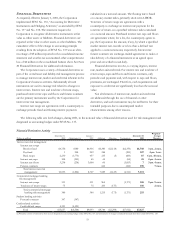PNC Bank 2001 Annual Report Download - page 48
Download and view the complete annual report
Please find page 48 of the 2001 PNC Bank annual report below. You can navigate through the pages in the report by either clicking on the pages listed below, or by using the keyword search tool below to find specific information within the annual report.46
Corporation’s operations. Additional information is included
in Note 19 Regulatory Matters and Item 1 of the
Corporation’s Annual Report on Form 10-K.
RESTATEMENTS
Early in 2002, the Corporation announced two restatements
affecting previously reported financial results. See Note 3
Restatements. The Corporation is a defendant in several
lawsuits filed after announcement of the restatement related
to consolidation of subsidiaries of a third party financial
institution. The staffs of the Securities and Exchange
Commission and the Federal Reserve Board have informed
the Corporation that they are conducting inquiries into the
transactions that are the subject of such restatement. In
addition, the reputational risk created by the restatements
may have consequences to the Corporation in such areas as
business generation and retention, funding and liquidity that
cannot be predicted at this time.
MONETARY AND OTHER POLICIES
The financial services industry is subject to various monetary
and other policies and regulations of the United States
government and its agencies, which include the Federal
Reserve Board, the Office of the Comptroller of Currency
and the Federal Deposit Insurance Corporation as well as
state regulators. The Corporation is particularly affected by
the policies of the Federal Reserve Board, which regulates
the supply of money and credit in the United States. The
Federal Reserve Board’s policies influence the rates of
interest that PNC charges on loans and pays on interest-
bearing deposits and can also affect the value of on-balance-
sheet and off-balance-sheet financial instruments. Those
policies also influence, to a significant extent, the cost of
funding for the Corporation.
COMPETITION
PNC operates in a highly competitive environment, both in
terms of the products and services offered and the
geographic markets in which PNC conducts business. This
environment could become even more competitive in the
future. The Corporation competes with local, regional and
national banks, thrifts, credit unions and non-bank financial
institutions, such as investment banking firms, investment
advisory firms, brokerage firms, investment companies,
venture capital firms, mutual fund complexes and insurance
companies, as well as other entities that offer financial and
processing services, and through alternative delivery channels
such as the World Wide Web. Technological advances and
legislation, among other changes, have lowered barriers to
entry, have made it possible for non-bank institutions to
offer products and services that traditionally have been
provided by banks, and have increased the level of
competition faced by the Corporation. Many of the
Corporation’s competitors benefit from fewer regulatory
constraints and lower cost structures, allowing for more
competitive pricing of products and services.
DISINTERMEDIATION
Disintermediation is the process of eliminating the role of
the intermediary in completing a transaction. For the
financial services industry, this means eliminating or
significantly reducing the role of banks and other depository
institutions in completing transactions that have traditionally
involved banks. Disintermediation could result in, among
other things, the loss of customer deposits and decreases in
transactions that generate fee income.
ASSET MANAGEMENT PERFORMANCE
Asset management revenue is primarily based on a
percentage of the value of assets under management and
performance fees expressed as a percentage of the returns
realized on assets under management. A decline in the value
of debt and equity instruments, among other things, could
cause asset management revenue to decline.
Investment performance is an important factor for the
level of assets under management. Poor investment
performance could impair revenue and growth as existing
clients might withdraw funds in favor of better performing
products. Also, performance fees could be lower or
nonexistent. Additionally, the ability to attract funds from
existing and new clients might diminish.
FUND SERVICING
Fund servicing fees are primarily based on the market value
of the assets and the number of shareholder accounts
administered by the Corporation for its clients. A rise in
interest rates or a sustained weakness or further weakening
or volatility in the debt and equity markets could influence an
investor’s decision to invest or maintain an investment in a
mutual fund. As a result, fluctuations may occur in the level
or value of assets that the Corporation has under
administration. A significant investor migration from mutual
fund investments could have a negative impact on the
Corporation’s revenues by reducing the assets and the
number of shareholder accounts it administers. There has
been and continues to be merger, acquisition and
consolidation activity in the financial services industry.
Mergers or consolidations of financial institutions in the
future could reduce the number of existing or potential fund
servicing clients.









